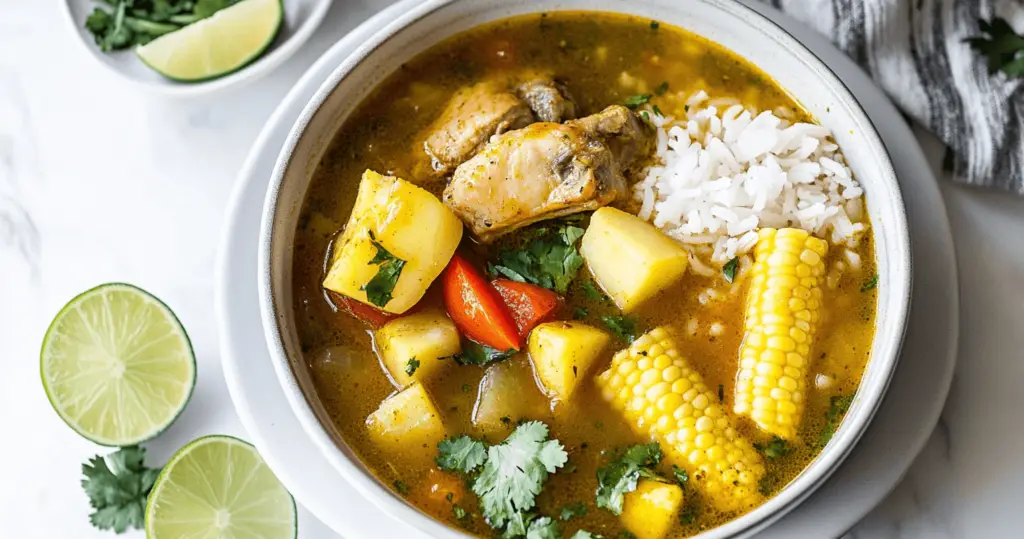Sancocho Colombiano is a hearty, traditional stew from Colombia, known for its rich flavors and comforting qualities. This dish combines a variety of meats, vegetables, and tubers, simmered together to create a flavorful and nourishing meal. It is often enjoyed during family gatherings, celebrations, and on weekends, serving as a symbol of Colombian culinary heritage.

Overview of Sancocho Colombiano
Sancocho Colombiano typically includes ingredients such as chicken, beef, or fish, along with plantains, yuca, potatoes, corn, and a variety of herbs and spices. The stew is known for its deep, savory broth and the way it brings together a variety of textures and flavors in one pot. Each region of Colombia has its own version of sancocho, reflecting local ingredients and culinary traditions.
Brief History and Cultural Significance
Sancocho has its roots in Spanish colonial cooking, evolving over time with influences from indigenous and African culinary traditions. In Colombia, sancocho has become a beloved national dish, with each region adding its unique twist. It is often prepared for special occasions and gatherings, symbolizing community and togetherness. The dish’s versatility and hearty nature make it a favorite comfort food for many Colombians.
Preparation Phase & Tools to Use
Making Sancocho Colombiano requires some preparation and the right tools to ensure success. Here are the key elements you need to know:
- Prep Time: 30 minutes
- Cook Time: 2-3 hours
- Cool Time: 10 minutes
- Total Time: 2 hours 40 minutes to 3 hours 40 minutes
- Servings: 8 servings
- Yield: One large pot of sancocho
Essential Tools and Equipment
To make Sancocho Colombiano, you will need the following tools and equipment:
- Large Stockpot: For cooking the sancocho.
- Cutting Board: For chopping vegetables and meats.
- Chef’s Knife: For precise and efficient chopping.
- Peeler: To peel vegetables like plantains and yuca.
- Tongs: For handling hot ingredients.
- Ladle: For serving the sancocho.
- Measuring Cups and Spoons: For accurate measurements of ingredients.
- Bowls: For holding chopped ingredients and serving the sancocho.
Each of these tools plays a crucial role in the preparation of sancocho, ensuring that the process is smooth and the end result is a perfectly crafted dish.
Importance of Each Tool
Large Stockpot: Essential for holding all the ingredients and allowing them to simmer together to develop the deep flavors characteristic of sancocho.
Cutting Board and Chef’s Knife: Necessary for safely and efficiently chopping vegetables and meats into appropriate sizes.
Peeler: Useful for peeling tough-skinned vegetables like plantains and yuca, making them easier to cook and eat.
Tongs: Helpful for turning meats and handling hot ingredients during cooking.
Ladle: Makes serving the stew easy and ensures that each serving gets a bit of everything.
Measuring Cups and Spoons: Important for adding the right amount of spices, herbs, and other ingredients to achieve the perfect flavor balance.
Bowls: Handy for organizing prepped ingredients and serving the finished dish.
Preparation Tips
To ensure your Sancocho Colombiano turns out perfectly, consider these tips:
- Prep Ingredients Ahead: Chop all vegetables and meats before you start cooking to streamline the process.
- Use Fresh Ingredients: Fresh vegetables and high-quality meats will enhance the flavor of your sancocho.
- Simmer Slowly: Allow the stew to simmer slowly to develop deep, rich flavors.
- Season Gradually: Add salt and spices gradually, tasting as you go to avoid over-seasoning.
- Remove Excess Fat: Skim off any excess fat that rises to the surface during cooking for a cleaner broth.
Ingredients List
Here’s what you’ll need to make Sancocho Colombiano:
- 1 whole chicken, cut into pieces (or 2 lbs beef shank or 2 lbs fish fillets)
- 2 ears of corn, cut into pieces
- 2 green plantains, peeled and cut into chunks
- 2 yuca roots, peeled and cut into chunks
- 4 potatoes, peeled and cut into chunks
- 1 large onion, chopped
- 4 garlic cloves, minced
- 1 red bell pepper, chopped
- 2 tomatoes, chopped
- 1 bunch cilantro, chopped
- 2 tbsp vegetable oil
- 8 cups chicken or beef broth (or fish stock)
- 2 tsp ground cumin
- 1 tsp ground achiote (annatto)
- Salt and pepper to taste
- Lime wedges for serving
Step-by-Step Instructions
Follow these detailed instructions to make your Sancocho Colombiano:
- Prep the Ingredients: Chop all vegetables and meats into appropriate sizes. Peel and cut the plantains, yuca, and potatoes into chunks.
- Sauté Aromatics: In a large stockpot, heat the vegetable oil over medium heat. Add the chopped onion, garlic, bell pepper, and tomatoes. Sauté until the vegetables are softened and aromatic.
- Brown the Meat: Add the chicken pieces (or beef shank) to the pot. Brown the meat on all sides to develop flavor.
- Add Broth and Spices: Pour in the chicken or beef broth (or fish stock) and add the ground cumin, ground achiote, salt, and pepper. Bring the mixture to a boil.
- Simmer: Reduce the heat to low and let the stew simmer for about 1 hour if using chicken or fish, or 2-3 hours if using beef shank. This allows the meat to become tender and the flavors to meld.
- Add Vegetables: Add the corn pieces, plantains, yuca, and potatoes to the pot. Continue to simmer until the vegetables are tender, about 30 minutes.
- Finish with Cilantro: Stir in the chopped cilantro and adjust the seasoning with more salt and pepper if needed.
- Serve: Ladle the sancocho into bowls, ensuring each serving has a mix of meat, vegetables, and broth. Serve with lime wedges on the side.
Side Dish Recommendations
Sancocho Colombiano is a hearty and filling stew that can be complemented by a variety of side dishes. Here are some traditional and popular side dish recommendations to enhance your sancocho experience:
1. White Rice (Arroz Blanco)
- Description: Fluffy white rice is a classic accompaniment to sancocho. It helps to soak up the flavorful broth and provides a mild contrast to the rich stew.
- Preparation: Cook rice according to package instructions, using chicken broth instead of water for added flavor.
2. Avocado (Aguacate)
- Description: Sliced avocado adds a creamy texture and fresh flavor that pairs well with the savory sancocho.
- Preparation: Slice ripe avocados and serve them on the side or add them directly to the stew.
3. Arepas
- Description: These cornmeal cakes are a staple in Colombian cuisine. They are perfect for dipping into the sancocho or enjoying as a side.
- Preparation: Make a dough with cornmeal, water, and salt. Shape into patties and cook on a griddle until golden brown.
4. Fried Plantains (Plátanos Fritos)
- Description: Sweet and caramelized fried plantains provide a delicious contrast to the savory stew.
- Preparation: Slice ripe plantains and fry them in hot oil until golden brown. Sprinkle with a little salt before serving.
5. Aji Picante (Colombian Hot Sauce)
- Description: A spicy and tangy sauce that adds a kick to the sancocho. It’s made with hot peppers, cilantro, lime juice, and green onions.
- Preparation: Blend hot peppers, cilantro, lime juice, green onions, and a pinch of salt until smooth. Serve in small bowls for drizzling over the stew.
6. Ensalada de Aguacate y Tomate (Avocado and Tomato Salad)
- Description: A simple and refreshing salad made with avocado, tomato, red onion, and cilantro, dressed with lime juice and olive oil.
- Preparation: Dice avocado and tomato, thinly slice red onion, and chop cilantro. Toss with lime juice, olive oil, salt, and pepper.
7. Patacones (Fried Green Plantains)
- Description: Twice-fried green plantains that are crispy and savory, perfect for dipping into the sancocho broth.
- Preparation: Slice green plantains into thick rounds, fry them until lightly golden, flatten with a plate, and fry again until crispy. Sprinkle with salt.
8. Corn on the Cob (Mazorca)
- Description: Grilled or boiled corn on the cob adds a sweet and crunchy element to the meal.
- Preparation: Grill or boil corn until tender. Serve with butter and a sprinkle of salt.
9. Fresh Lime Wedges
- Description: Lime wedges add a burst of citrus that enhances the flavors of the sancocho.
- Preparation: Cut fresh limes into wedges and serve on the side for squeezing over the stew.
10. Cassava Bread (Pan de Yuca)
- Description: A traditional Colombian bread made with yuca flour and cheese. It’s slightly chewy and pairs well with the hearty stew.
- Preparation: Mix yuca flour, grated cheese, eggs, and butter to form a dough. Shape into small rolls and bake until golden brown.
Health Benefits of Ingredients
- Plantains and Yuca: Both are rich in dietary fiber, which aids in digestion and helps maintain a healthy gut.
- Chicken and Beef: High-quality sources of protein that support muscle repair and growth.
- Fish: Provides omega-3 fatty acids, which are beneficial for heart health and brain function.
- Vegetables: Packed with antioxidants that help protect the body from oxidative stress and inflammation.
Tips, Notes, Storing, and Serving
Tips for the Perfect Sancocho:
- Prep Ingredients Ahead: Chop all vegetables and meats before you start cooking to streamline the process.
- Use Fresh Ingredients: Fresh vegetables and high-quality meats will enhance the flavor of your sancocho.
- Simmer Slowly: Allow the stew to simmer slowly to develop deep, rich flavors.
- Season Gradually: Add salt and spices gradually, tasting as you go to avoid over-seasoning.
- Remove Excess Fat: Skim off any excess fat that rises to the surface during cooking for a cleaner broth.
- Layer Flavors: Add ingredients in stages to build layers of flavor. For example, start with sautéing aromatics, then add meat and simmer, followed by adding starchy vegetables and finally leafy greens and fresh herbs.
- Serve Hot: Sancocho is best served piping hot to fully enjoy its rich and hearty flavors.
Notes on Ingredient Substitutions:
- Meat Alternatives: For a vegetarian version, replace the meat with hearty vegetables like mushrooms, zucchini, and additional root vegetables.
- Broth Alternatives: Use vegetable broth instead of chicken or beef broth for a lighter, vegetarian-friendly stew.
- Yuca Alternatives: If yuca is not available, you can substitute it with potatoes or sweet potatoes for a different texture and flavor.
Storing Sancocho:
- Refrigeration: Allow the sancocho to cool completely before transferring it to an airtight container. Store in the refrigerator for up to 3 days.
- Freezing: Sancocho can be frozen for up to 3 months. Cool the stew completely, then portion it into freezer-safe containers or heavy-duty freezer bags. Thaw in the refrigerator overnight before reheating.
Serving Suggestions:
- Family Style: Serve sancocho in a large pot or serving bowl placed in the center of the table. Allow guests to serve themselves, ensuring they get a mix of broth, meat, and vegetables.
- Individual Bowls: Ladle the sancocho into individual bowls, making sure each serving includes a bit of everything.
- Garnish: Add fresh chopped cilantro, lime wedges, and a dollop of ají picante for extra flavor.
- Accompaniments: Serve with any of the recommended side dishes such as white rice, avocado, arepas, or fried plantains to complement the stew.
FAQs
What is Sancocho Colombiano?
Sancocho Colombiano is a traditional Colombian stew made with a variety of meats, vegetables, and tubers. It typically includes chicken, beef, or fish, along with plantains, yuca, potatoes, and corn, simmered together to create a rich and flavorful broth. It is a popular dish for family gatherings and celebrations.
Can you make Sancocho Colombiano ahead of time?
Yes, you can make sancocho ahead of time. In fact, it often tastes better the next day as the flavors have more time to meld. Prepare the stew and store it in the refrigerator for up to 3 days. Reheat gently on the stove before serving.
What are some variations of Sancocho Colombiano?
Popular variations of sancocho include Sancocho de Gallina (chicken sancocho), Sancocho de Res (beef sancocho), Sancocho de Pescado (fish sancocho), and vegetarian sancocho. Each variation uses different types of protein and sometimes different vegetables, but the core concept of a hearty, flavorful stew remains the same.
How long does Sancocho Colombiano last in the fridge?
Sancocho Colombiano can be stored in an airtight container in the refrigerator for up to 3 days. Reheat thoroughly on the stove before serving.
Can you freeze Sancocho Colombiano?
Yes, you can freeze sancocho for up to 3 months. Allow the stew to cool completely before transferring it to freezer-safe containers or bags. Label with the date and contents, and thaw in the refrigerator overnight before reheating.
Conclusion
Sancocho Colombiano is a beloved traditional dish that embodies the rich culinary heritage of Colombia. Its hearty, flavorful broth, tender meats, and variety of vegetables make it a perfect comfort food for family gatherings and special occasions. By following the detailed instructions and tips provided in this guide, you can create a delicious and authentic sancocho that will impress your family and friends. Enjoy experimenting with different variations and side dishes to make this dish your own.
Print
Sancocho Colombiano
Description
Learn how to make delicious Sancocho Colombiano with our comprehensive guide. Discover tips, variations, and serving suggestions for this traditional Colombian stew.
Ingredients
Ingredients List
Here’s what you’ll need to make Sancocho Colombiano:
- 1 whole chicken, cut into pieces (or 2 lbs beef shank or 2 lbs fish fillets)
- 2 ears of corn, cut into pieces
- 2 green plantains, peeled and cut into chunks
- 2 yuca roots, peeled and cut into chunks
- 4 potatoes, peeled and cut into chunks
- 1 large onion, chopped
- 4 garlic cloves, minced
- 1 red bell pepper, chopped
- 2 tomatoes, chopped
- 1 bunch cilantro, chopped
- 2 tbsp vegetable oil
- 8 cups chicken or beef broth (or fish stock)
- 2 tsp ground cumin
- 1 tsp ground achiote (annatto)
- Salt and pepper to taste
- Lime wedges for serving
Instructions
Step-by-Step Instructions
Follow these detailed instructions to make your Sancocho Colombiano:
- Prep the Ingredients: Chop all vegetables and meats into appropriate sizes. Peel and cut the plantains, yuca, and potatoes into chunks.
- Sauté Aromatics: In a large stockpot, heat the vegetable oil over medium heat. Add the chopped onion, garlic, bell pepper, and tomatoes. Sauté until the vegetables are softened and aromatic.
- Brown the Meat: Add the chicken pieces (or beef shank) to the pot. Brown the meat on all sides to develop flavor.
- Add Broth and Spices: Pour in the chicken or beef broth (or fish stock) and add the ground cumin, ground achiote, salt, and pepper. Bring the mixture to a boil.
- Simmer: Reduce the heat to low and let the stew simmer for about 1 hour if using chicken or fish, or 2-3 hours if using beef shank. This allows the meat to become tender and the flavors to meld.
- Add Vegetables: Add the corn pieces, plantains, yuca, and potatoes to the pot. Continue to simmer until the vegetables are tender, about 30 minutes.
- Finish with Cilantro: Stir in the chopped cilantro and adjust the seasoning with more salt and pepper if needed.
- Serve: Ladle the sancocho into bowls, ensuring each serving has a mix of meat, vegetables, and broth. Serve with lime wedges on the side.
Notes
- Meat Alternatives: For a vegetarian version, replace the meat with hearty vegetables like mushrooms, zucchini, and additional root vegetables.
- Broth Alternatives: Use vegetable broth instead of chicken or beef broth for a lighter, vegetarian-friendly stew.
- Yuca Alternatives: If yuca is not available, you can substitute it with potatoes or sweet potatoes for a different texture and flavor.


Leave a Comment